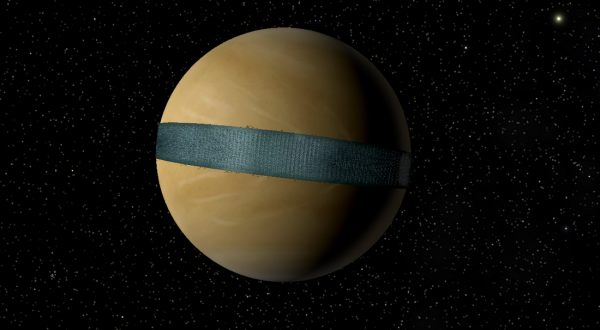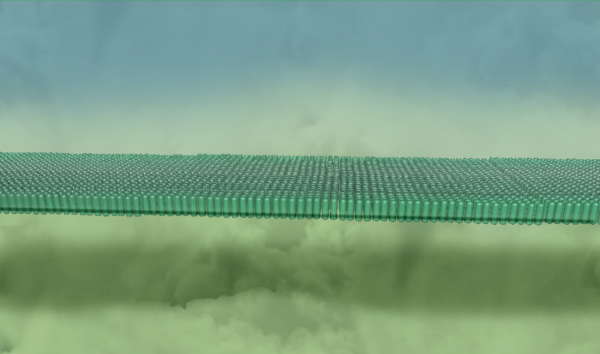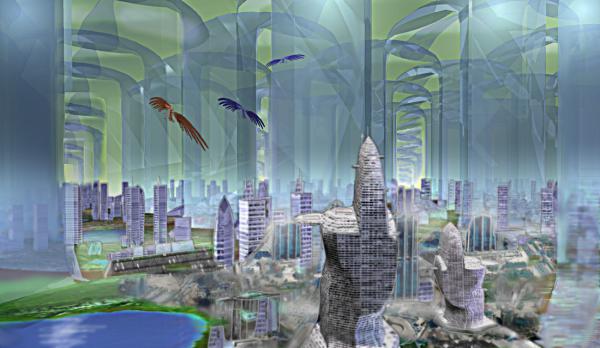BY LETTER
Blanchard
Galactography > Regions of Space > Inner Sphere
Galactography > Systems and Worlds > Systems & Worlds A - B
Galactography > Systems and Worlds > Systems & Worlds A - B
Venus-like world with a contiguous layer of inhabitable bubblehabs | |
 Image from Steve Bowers | |
| When the bubblehab layer was a thousand miles wide it became known as the Equatorial Tape | |
Star Beta Caeli
Distance from Sol 93 ly
Type F3V
Luminosity 6.79 x Sol
Constellation Caelum
World: Blanchard
Type Cytherean (Venus-like)
Diameter 11908 km
Surface Temperature 440K
Rotational Period 178 standard hours
Orbital period 2.04 standard years
Semimajor Axis 1.9 AU
Other Worlds; Mevlevi (rapidly rotating gas giant), AgGardna, Tyl (2000km planetoids)
Beta Caeli was reached in 1522 A.T. by the Undyoist colony ship Qian Kun. The system contained one rapidly rotating gas giant (Mevlevi) which was unsuitable for bubblehabs, a number of smaller rocky and icy planetoids, and one Venus-like planet with a strong greenhouse effect. The surface of this world was too hot for the nearbaseline human colonists who arrived on the Qian Kun, but (like Venus itself) the atmosphere became cooler with height, reaching an Earth-like temperature and pressure at around 48km from the surface. As well as establishing small mining colonies on the planetoids of this system (each manned by a few dozen individuals) the Undyoists began to establish bubblehabs in the atmosphere of this world, which they named Blanchard.
Using self-replicating technology the bubblehabs were constructed relatively quickly, using carbon and oxygen from the atmosphere while extracting hydrogen from the sulphuric acid clouds to make organic compounds and water. Other elements were mined using remote-controlled drone equipment on the planet's hot surface.
Population on Blanchard increased rapidly as new colony ships arrived from the Inner Federation, carrying with them more Undyoists and a smaller number of Etodists. By 1622 there were several hundred bubblehabs, all occupying a narrow band around the equator. Although the planet took 178 standard hours to rotate, the atmosphere at the equator rotated once every 71 hours. The winds at the habitable level were moderately turbulent, and as the bubblehabs became more numerous and larger the potential for collisions increased.
The Tahmetian Conflict
Towards the end of the First Federation Era several Tahmetian ships arrived from Alpha Caeli, a system which received a visit from one of the miraculous Five Prophets. The Tahmetians ignored Blanchard, but began to occupy several small objects in the middle system, including the planetoids AgGardna and Tyl. Some of these they purchased legitimately, using Federation credit; others they acquired by infiltration or fraud. In 2107 the Federation Representative left the system, leaving these worlds without transapient guidance. Finding that their interstellar credit was now effectively worthless the Tahmetians started to invade the remaining worlds. Most of the remaining asteroids, moons and planetoids fell to their invading troopships; the pacifist Undyoists gave no resistance, although there were spirited defences of several worlds by Etodist defenders.When the Tahmetians attempted to attack Blanchard they were kept at bay by Etodist gunships, powerful unmanned particle cannon capable of engaging incoming vessels at a considerable distance. For this reason the Tahmetians kept their distance, and instead sent salvos of kinetic missiles towards the bubble habs. These missiles rarely found their target, either being vapourised on the way in or missing the fast-drifting habs altogether. However, to the Etodists' dismay, the Undyoists simply invited the Tahmetians to enter Blanchard without a fight. If the Tahmetians wanted this world so badly, they could have it. Neither the Etodist minority on this world, or the invaders, could believe their ears/data receptors. However the Undyoists had not abandoned the fight; once the Tahmetians were allowed into the floating worlds of Blanchard they found themselves under sophisticated memetic attack.
In some respects this was easy; the Undyoists were aware of many weaknesses in the Tahmetian religio-political meme-set. Soon after the foundation of Tahmetianity the sceptical Undyoists had proved to their own satisfaction that the Five Prophets were fraudulent, nothing more than multiple instances of a single person replicated by the (then-still-unfamiliar) engeneration technology. Most of the upper echelons of the Tahmetian military ruling-class were aware of this so-called proof, but they were able to dismiss it as propaganda. Most rank-and-file Tahmetians were kept unaware of the arguments against their religion, and the few that knew were encouraged to think of them as a challenge to their faith. Thanks to the subtle nature of the Undyoist assault, the Tahmetians did not realise what was happening until it was too late. After ten local years (around twenty standard years) most Tahmetians on Blanchard had become sceptical of their faith to some degree; the ruling Tahmetian command structure collapsed, allowing the invaders to become integrated with, and assimilated by, the local culture. Only a few fundamentalists remained, and these retreated to their worlds in the planetoid belt.
The Equatorial Tape
 Image from Steve Bowers | |
| The Equatorial Tape when it was only twenty kilometres across | |
During the next thousand years Blanchard consolidated its bubblehab fleet into a continuous structure. At first a single row of habitats that circled the globe, in due course the band of linked habitats reached two thousand kilometres in width. Since breathable air on this world is a lifting gas compared to the carbon-dioxide/nitrogen mix outside, the balloons are self-supporting; where two balloons touch they can share an opening, generally a long rounded rectangle through which air and traffic can pass. The linked balloons are generally a kilometre across and three high, with buildings, parkland or agricultural facilities on or near the floor of the balloon. This long, shiny artefact that encircles the globe resembles adhesive tape as seen from orbit, and is known as the Equatorial Tape.
New Tahmetianity
Even though Tahmetianity had become a minor faction in the Terragen sphere after the failure of the Tahmetian Crusades, the fundamentalists in this system remained relatively strong; by 3200 their core worlds. AgGardna and Tyl were heavily fortified and at the centre of a network of military bases. Etodist ships patrolled the borders of the Belt but were restricted by treaty to observer status. A new, revived form of Tahmetianity emerged. It considered the Five Prophets to be a metaphor, one which highlighted the faithless and skeptical nature of the Undyoists. In 3230 the New Tahmetians goaded the Etodists into conflict, giving them a pretext to attack Blanchard which, they claimed, was acting as a haven for Etodian pirates.Originating in the outer belt, a geometric array of kinetic missiles headed towards Blanchard. Now that the Tape was such a large target, the Tahmetian sabots could not fail to find their target this time. However the regular formation of this array made it easier for the Etodist gunships to locate and destroy the missiles as they approached Blanchard; in the event only a handful got through. Each missile pierced the Tape from top to bottom, releasing enough kinetic energy to detroy several adjacent balloons. Since the balloons were under positive pressure with respect to the atmosphere at that height, the air began to blow out of the nearby chambers, but very little of the poisonous external atmosphere got in. Temporary internal doors had been closed between the bubbles when the missiles had first been sighted; but flying debris pierced many of the surrounding balloons, causing a circle of destruction tens of kilometres across around each impact. As the atmosphere leaked out, each damaged balloon began to sag, causing standing water to flow and cause flooding (compounding the plight of the inhabitants). Eventually the atmosphere inside and outside equalised in the damaged balloons, and toxic CO2 and H2SO4 seeped in. In most cases the inhabitants were rescued before these reached dangerous levels, but a few citizens who survived being trapped by tilting landscapes and by floods were poisoned.
In the war that followed the pacifist Undyoists once again took no active part, but they were instrumental in deprogramming the most fanatical of the New Tahmetians once AgGardner and Tyl were finally subdued. Nevertheless the Undyoists had lost much popular support, and they became a minor faction on the world they founded long before.
The Integration
 Image from Steve Bowers | |
| Interior of the Blanchard Tape, with some citizens using wingpacks to fly between the structures | |
Most Blanchard citizens were now either Etodists or agnostic skeptics that rejected even the minimalist Taoism that formed the basis of Undyoism. An increasing number were attracted to archaitheology, even though the system had been without transapient presence for over a thousand years. In 3879 the Blanchard Tape voted to invite the NoCoZo to send a representative transapient to give them assistance and guidance; they expected to get a single First Singularity visitor, but instead several dozen transapients arrived, including in due course a S:2 Higher transapient. These entities set about reshaping the Belt and the gas giant, and established high-tech infrastructure near the star and in the outer system. Beta Caeli entered a golden age, interrupted only by skirmishes in the Oort Cloud between the transapients and Solar Dominion raiders.
Blanchard Touchdown
During the CompEmp period Blanchard's raft began to expand once more, until it covered the entire planet in 7555. The concept of a floating raft of habitats dates back to the Information Age, and can be traced back to the work of the early futurist Paul Birch. In Birch's original idea, once the planet was covered the carbon dioxide atmosphere beneath the raft (now in shadow) would liquefy and become an ocean. The raft would then touch down and float on this ocean, thanks to a thick layer of insulation. However geothermal heat from Blanchard's interior did not allow this to happen, so the raft continued to float on a dense layer of gaseous carbon dioxide for the next two thousand years. During this time carbon, nitrogen and oxygen were extracted for export, gradually depleting this reservoir until the raft touched down in 9081. Blanchard was finally terraformed in a conventional manner and the last bubbles were removed a hundred years later.The Current Era
Blanchard has never formally joined the NoCoZo; despite the reduced significance of Undyoism on this world, it has left its mark in the inhabitants' habitual sceptical outlook and empiricism even if the metaphysical aspects of Tao have become less important. Some citizens still yearn for the floating life, and many live in Fullair cities or vacuum dirigibles wandering in the new, clear blue skies.Related Articles
Appears in Topics
Development Notes
Text by Steve Bowers
Initially published on 16 June 2016.
Initially published on 16 June 2016.






